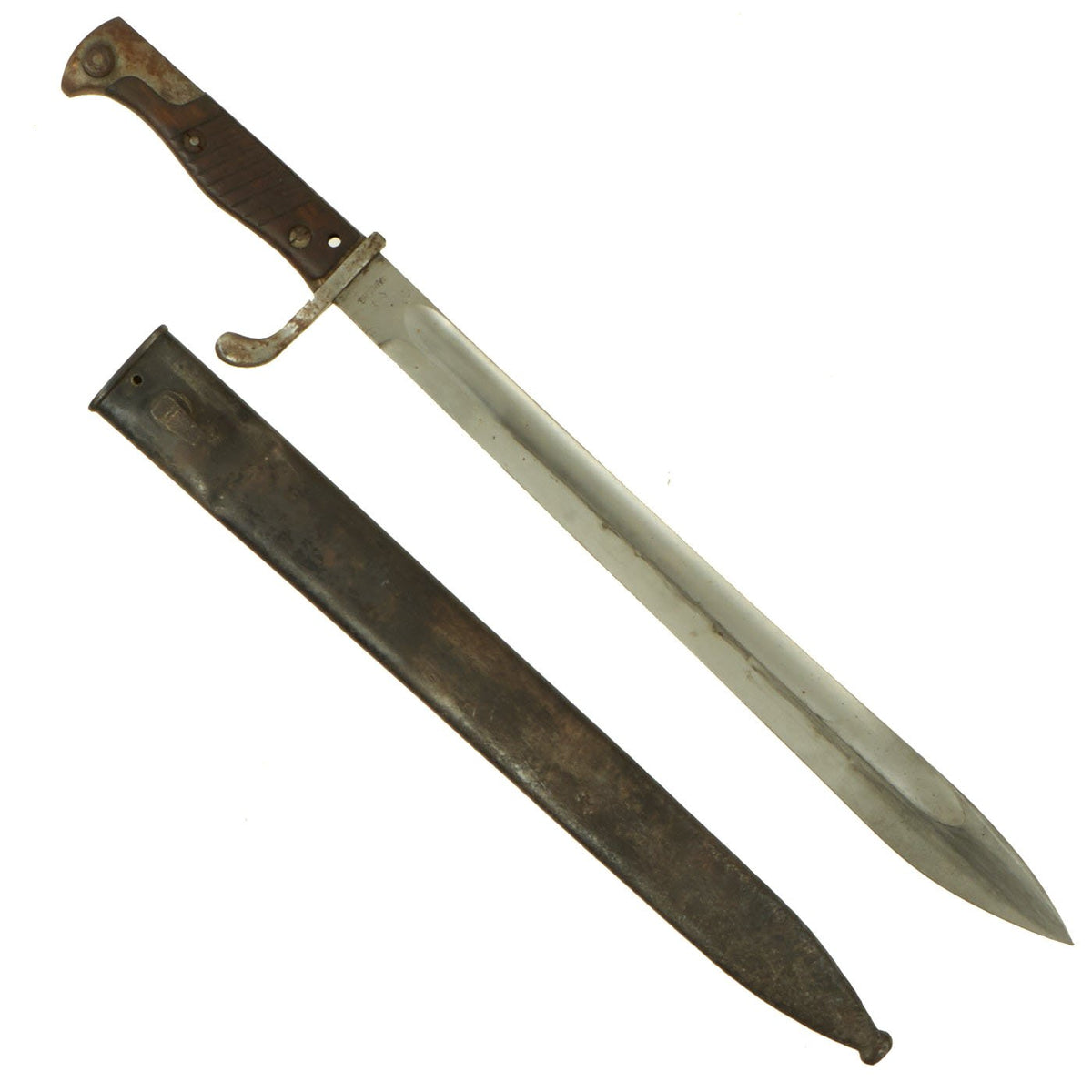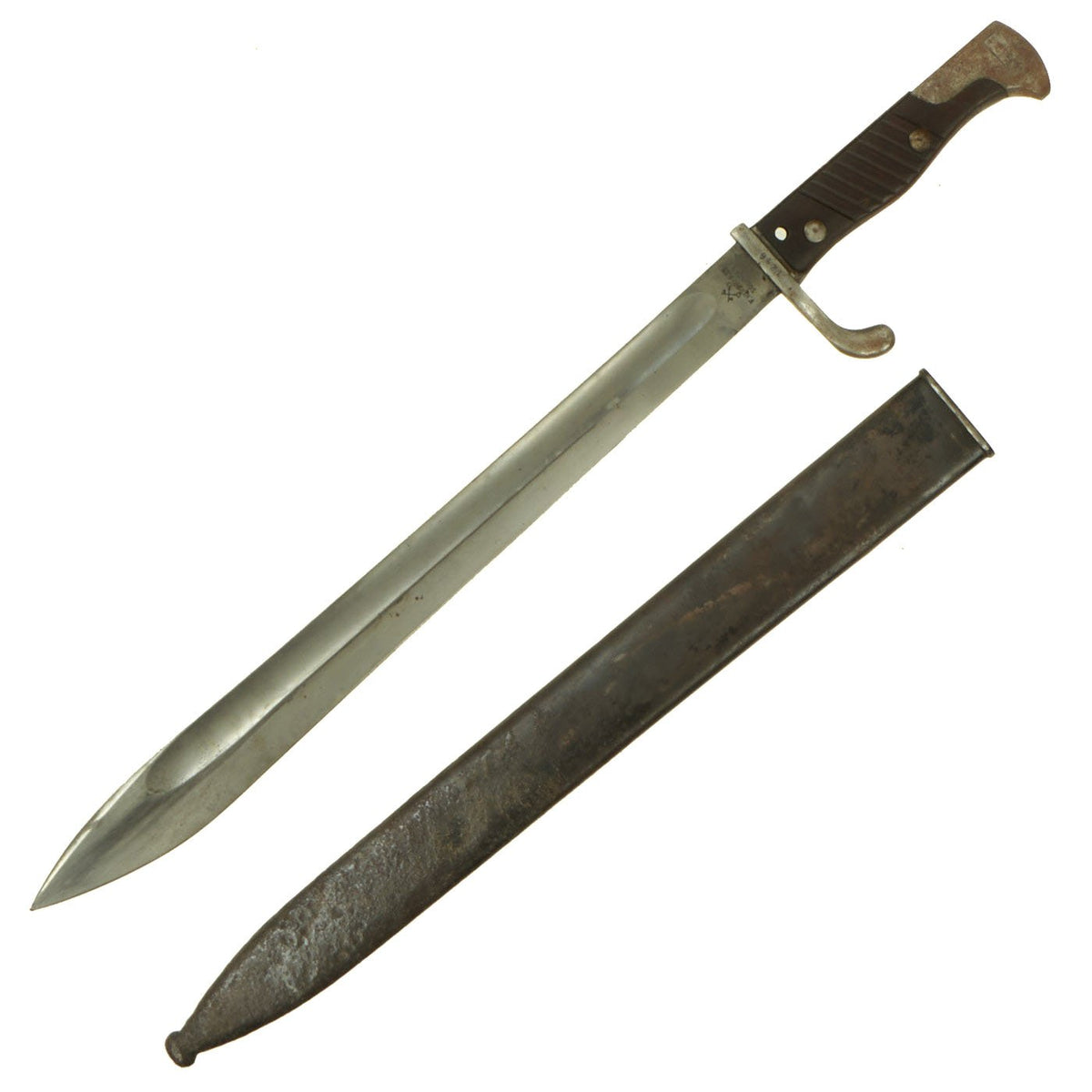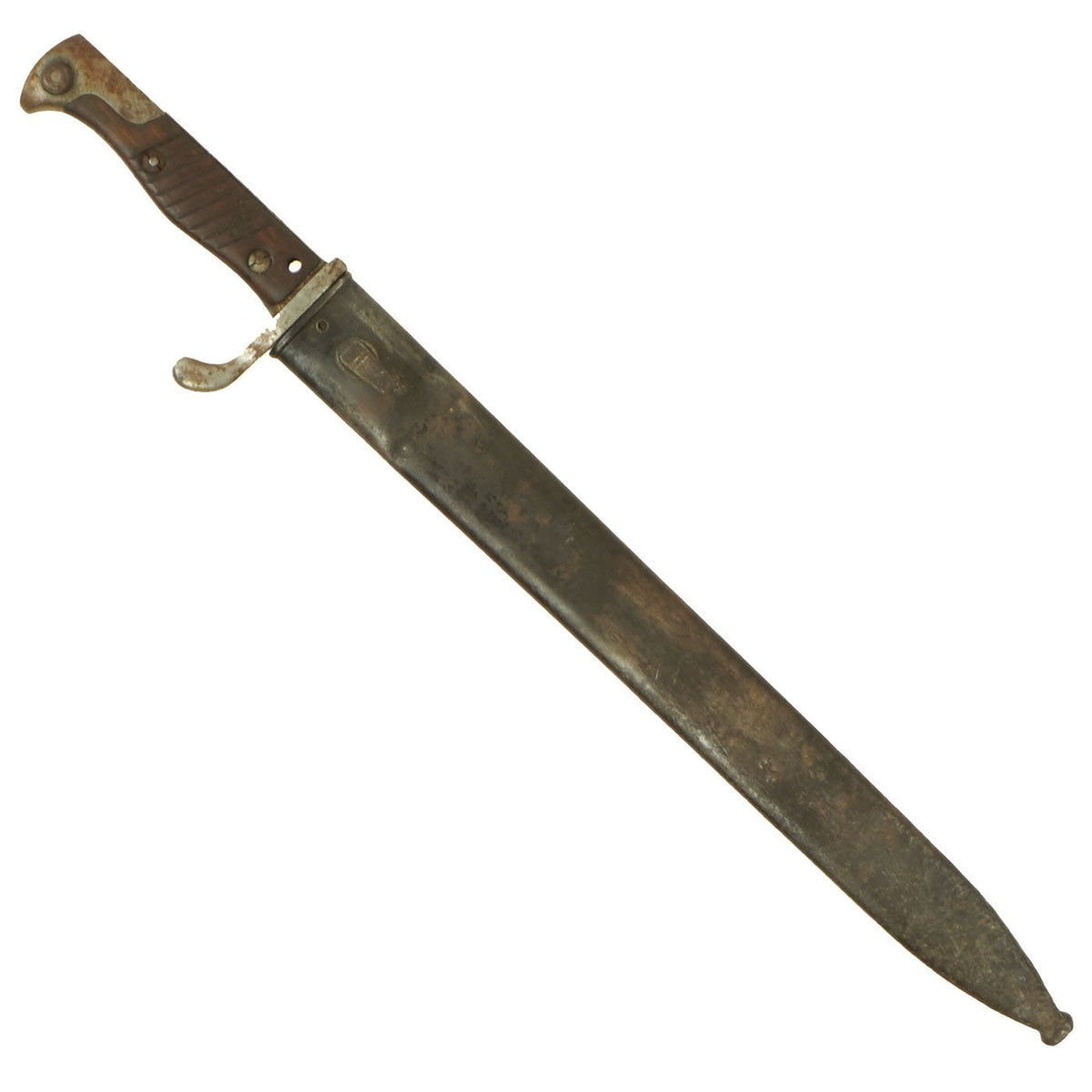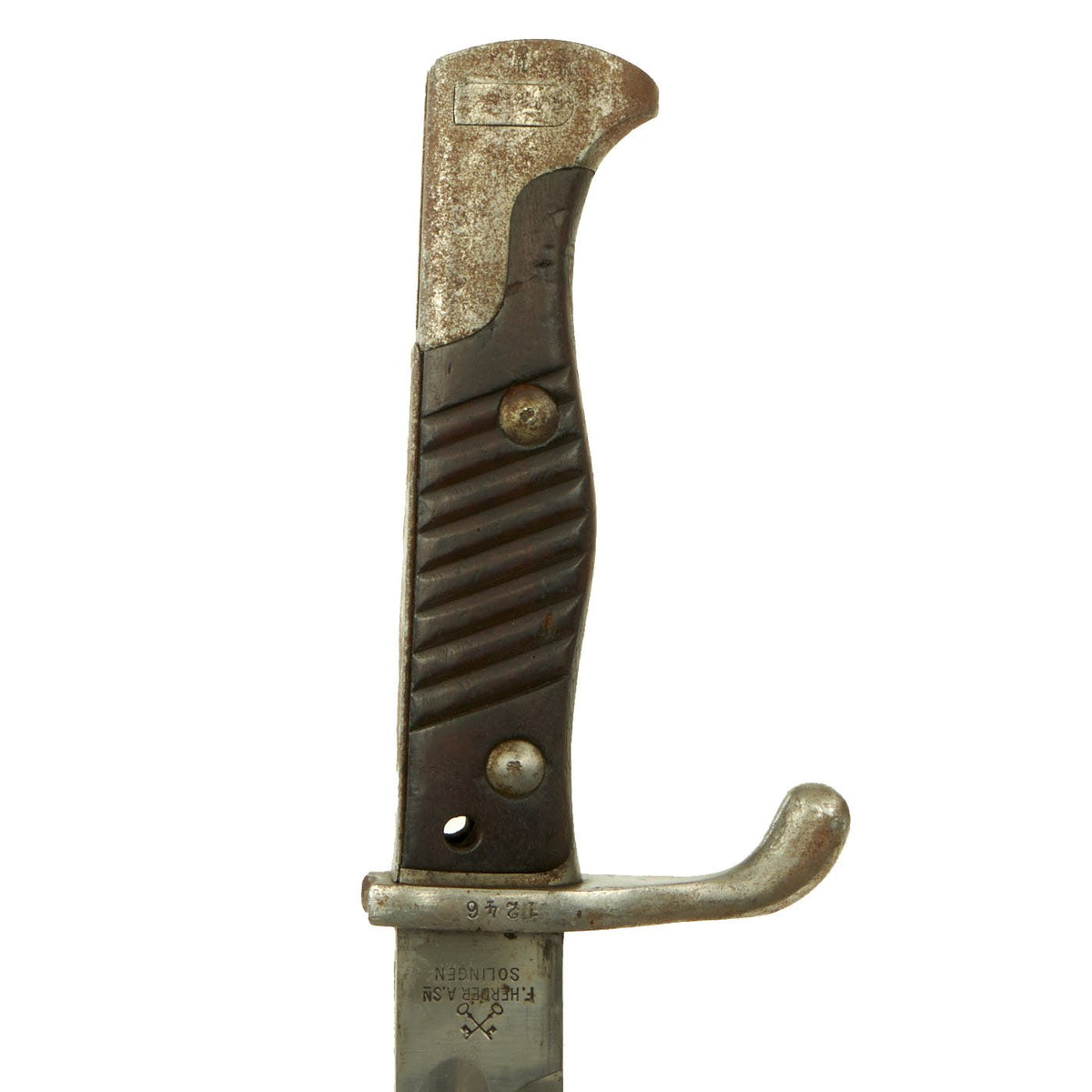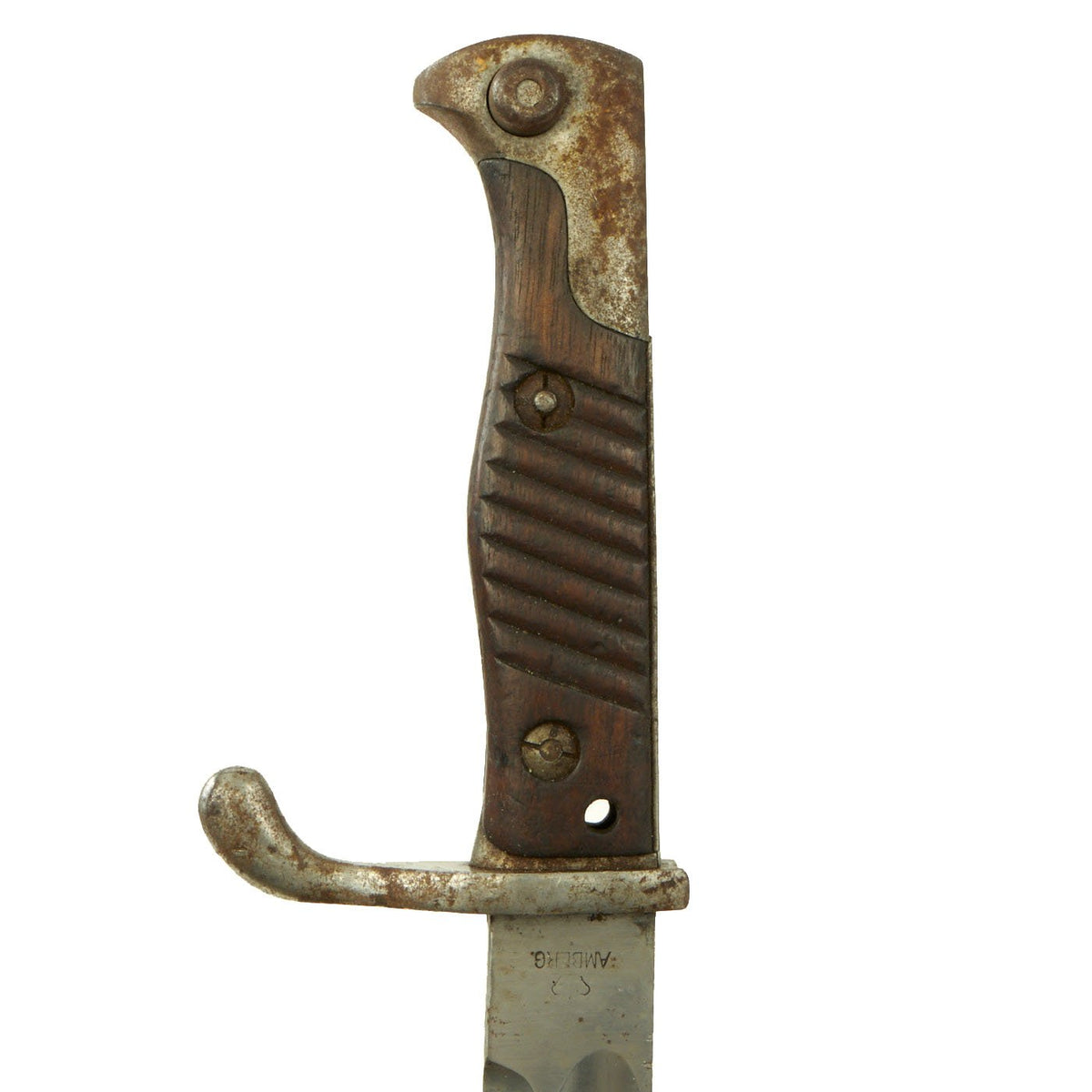Original German WWI M1898/05 n/A Butcher Bayonet by F. Herder Abr. Sohn with Bavarian Proof Mark & Scabbard Original Items
$ 250,00 $ 100,00
Original Item: Only One Available. This is a very good example of the M-1898/05 Bayonet (Seitengewehr), which was the most common German Bayonet of the First World War. It was intended for use on the standard issue service rifle of Imperial Germany: the Mauser-designed Gewehr 98 (GEW 98). It features a heavy 14.5-inch steel blade with distinct bulge toward the point, giving extra weight and power to the business end, known as a “butcher blade”. This version is known as n/A (neuer Art = newer model). This second pattern lacks the first pattern’s vestigial muzzle ring (or ‘ears’) and has a flashguard on the back of the grip.
This example has a very nice set of original grooved wood grips, with a few small dents and overall wear. There is a bit of peppered oxidation on the bright steel hilt, but it could most likely be cleaned away. We have left it intact to preserve the patina. The original proof marks are visible on the pommel, and the bayonet lock is still fully functional. The blade ricasso still has the original maker mark, which is still clear:
(CROSSED KEYS)
F. HERDER A. SN
SOLINGEN
Friedr. Herder Abr. Sohn. GmbH, Constant-Werk, Stahlwrarenfabik was a well known edged weapon producer from Solingen, the “City of Blades” in the mountains of Western Germany. According to J. Anthony Carter’s book, GERMAN KNIFE AND SWORD MAKERS, the Herder family can be traced back to 1623, when Arndt, Jürgen and Wilhelm Herder were making knives in Geylenbergh. In the 19th Century, Friedrich Herder formed his own company, Friedrich Herder Abraham Sohn (Abraham’s Son). The “crossed keys trademark was first trademarked in 1848, and renewed in 1895. This is definitely a company with a long history, part of a long established Solingen family.
The reverse ricasso shows the CROWN / AMBERG marking of Amberg Arsenal in Bavaria. We are not sure if this is an acceptance marking, or whether it means that Herder supplied the blades to the arsenal, who then fit them. The blade is dated on the blade’s spine 15 under a proof mark of a Crown over L, for King Ludwig III of Bavaria, and indicating the date it was accepted into service. Ludwig reigned as king from 1913 until 1918, when the Monarchy was abolished. Previously he had been the Prince Regent 1912-1913, as his cousin Otto was technically the King, however he was deemed unfit for rule, so his uncle and later cousin ruled in his stead. There is also an inspector proof under the date marking.
The blade on this example is really in great shape, with the original bright finish almost entirely retained, with almost no staining, and just a bit of runner wear. It was sharpened for issue, but does not appear to have been sharpened post arsenal.
The steel scabbard has fared somewhat worse, and has some sizeable dents, as well as pit rust oxidation on the last 6 inches of the scabbard. It did quite a good job of protecting the blade from damage and oxidation. The throat retaining screw is also missing, and overall the finish is relatively worn.
A fine example of what is becoming a difficult bayonet to find in any condition, just the way we like to find them, without any major alterations. Ready to display!
Specifications:
Blade Length: 14 5/8″
Blade Style: Butcher with Smoothback
Overall length: 19 3/4“
Crossguard: 3”
Scabbard Length: 15 1/4″
Fast Shipping with Professional Packaging
Thanks to our longstanding association with UPS FedEx DHL, and other major international carriers, we are able to provide a range of shipping options. Our warehouse staff is expertly trained and will wrap your products according to our exact and precise specifications. Prior to shipping, your goods will be thoroughly examined and securely secured. We ship to thousands clients each day across multiple countries. This shows how we're dedicated to be the largest retailer on the internet. Warehouses and distribution centres can be located throughout Europe as well as the USA.
Note: Orders with more than one item will be assigned a processing date depending on the item.
Before shipping before shipping, we'll conduct a thorough inspection of the items you have ordered. Today, the majority of orders will be delivered within 48 hours. The delivery time will be between 3-7 days.
Returns
The stock is dynamic and we cannot completely manage it because multiple stakeholders are involved, including our factory and warehouse. So the actual stock may alter at any time. It's possible that you may not receive your order once the order has been made.
Our policy is valid for a period of 30 days. If you don't receive the product within 30 days, we are not able to issue a refund or an exchange.
You can only return an item if it is unused and in the same state as the day you received it. You must have the item in its original packaging.
Related products
Uncategorized
Uncategorized
Uncategorized
Uncategorized
Uncategorized
Uncategorized
Armoured Fighting Vehicles of the World: AFVs of World War One (Hardcover Book) New Made Items
Uncategorized
Uncategorized
Uncategorized
Uncategorized
Uncategorized
Uncategorized
Australian WWII Owen MK1 Machine Carbine SMG Custom Fabricated Replica with Sling Original Items
Uncategorized
Uncategorized
Uncategorized
Uncategorized
Uncategorized
